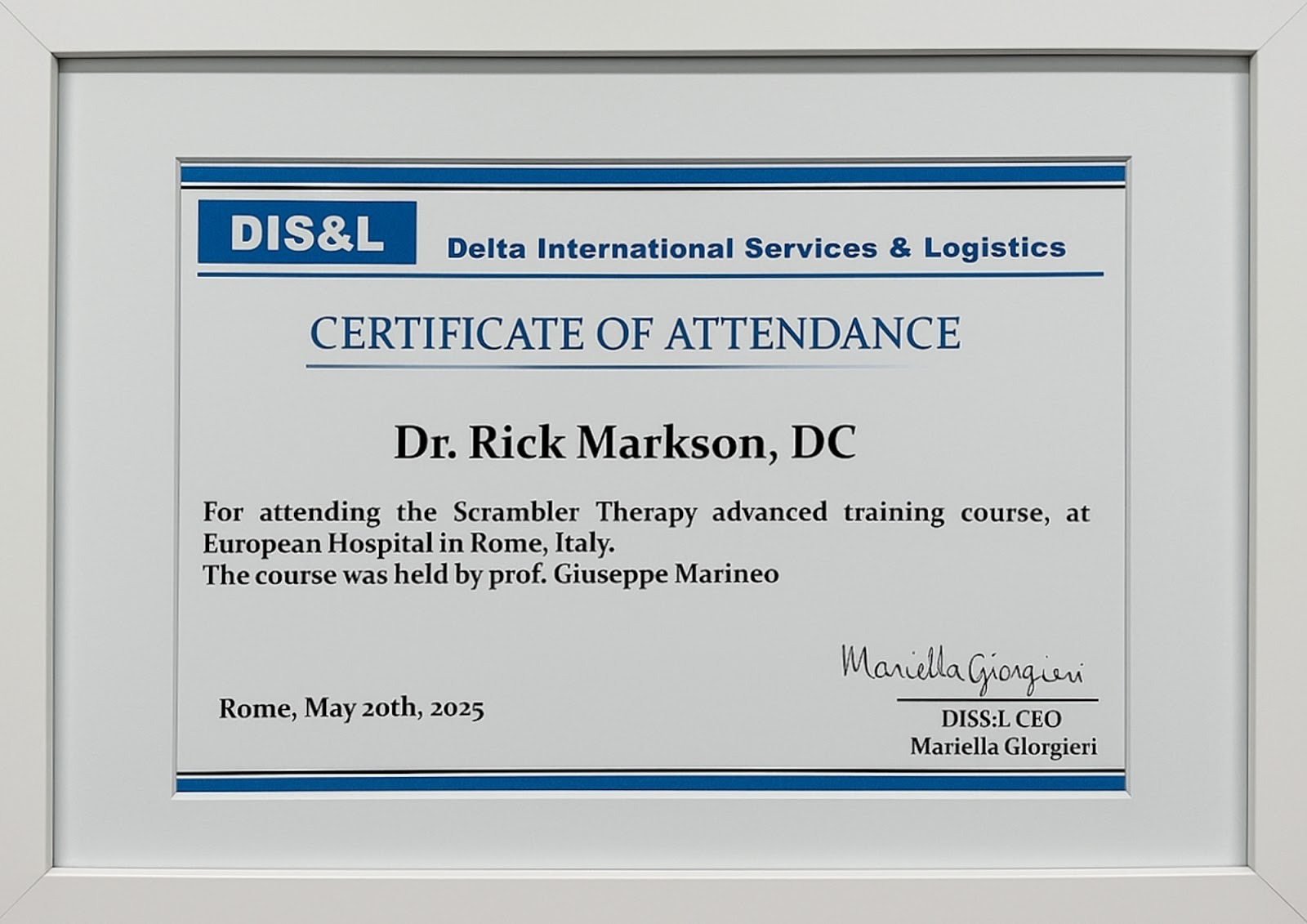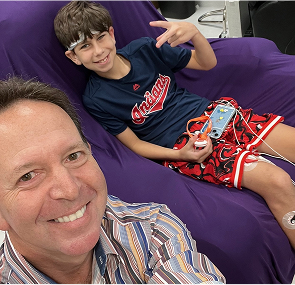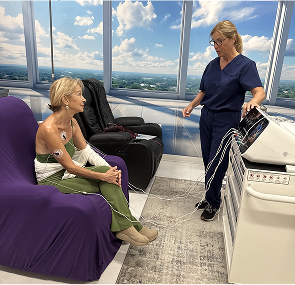Can I Combine Scrambler Therapy with Physical Therapy or Chiropractic
.jpg)
Scrambler Therapy is a non-invasive treatment that helps the nervous system reinterpret pain signals. It works by delivering synthetic, non-pain information to nerve endings through surface electrodes, effectively overriding abnormal pain messages that the brain receives from damaged or sensitized nerves.
Unlike traditional electrical stimulation therapies, this method targets chronic nerve pain by retraining the brain using specific waveforms designed to mimic normal sensory input. The result is a type of neural “reboot” that reduces pain without drugs or invasive procedures.
It’s particularly useful for people dealing with neuropathic conditions such as chemotherapy-induced nerve pain, fibromyalgia, or post-surgical nerve damage. Sessions are generally well-tolerated and can be repeated regularly for sustained relief.
Coming up, we’ll explore how physical therapy addresses the physical aspects of pain, including mobility and strength.
How Does Physical Therapy Support Pain Recovery?
Physical therapy plays a crucial role in restoring movement and rebuilding function after injury, surgery, or long-standing pain. Unlike Scrambler Therapy, which focuses on recalibrating the nervous system, physical therapy emphasizes the body’s mechanical and muscular systems.
A physical therapist creates a customized plan that may include joint mobilizations, guided stretching, strength-building routines, and techniques to improve posture and gait. These strategies are aimed at improving stability, coordination, and overall function, especially in cases where pain has led to deconditioning or mobility loss.
By focusing on movement patterns and neuromuscular control, therapy can help prevent future injuries while also supporting long-term recovery.
Next, let’s look at how chiropractic care targets the spine and nervous system in a different yet complementary way.
How Does Chiropractic Therapy Influence the Nervous System?
Chiropractic care centers on the belief that proper alignment of the spine can improve nerve function and relieve pain. Spinal misalignments, known as subluxations, may cause pressure on nerves or joints, which can trigger pain signals or restrict mobility.
By performing precise spinal adjustments, chiropractors aim to reduce tension around joints and promote better nervous system communication. This can lead to improved posture, decreased inflammation, and greater joint range of motion.
Chiropractic sessions often include soft tissue work, decompression techniques, and targeted manipulations that restore balance to the spine and surrounding structures.
In the next section, we’ll answer the main question—whether combining these treatments is safe and effective.
Can These Therapies Be Used Together?
Yes, combining Scrambler Therapy with physical therapy or chiropractic care is generally considered safe and often beneficial. Each approach targets different systems of the body and can complement the others without causing interference.
Scrambler Therapy works on the nervous system, helping to reprogram how the brain perceives pain. Physical therapy focuses on restoring movement and function, while chiropractic care aims to reduce nerve pressure by improving spinal alignment. Together, they form a comprehensive plan that addresses multiple pain sources.
Coordinating these treatments can help patients achieve better outcomes, especially when providers work collaboratively to adjust timing and intensity based on the individual's response.
In the following section, we’ll look at the available clinical evidence to support this combination approach.
Clinical Evidence: Is It Safe to Combine These Therapies?
Current evidence supports the safety and effectiveness of combining Scrambler Therapy with other modalities. However, research is still evolving, and large-scale trials are limited.
What Studies Show:
A 2020 review of ST clinical trials showed it significantly reduced chronic pain in various neuropathic conditions. Some case studies in pain clinics noted enhanced results when paired with movement therapy or spinal alignment treatments.
What Are the Biological Benefits of Combining These Therapies?
Combining these approaches offers several biological advantages. When used together, they can enhance recovery by addressing the pain from multiple directions—neurologically, structurally, and functionally.
Scrambler Therapy promotes neural rewiring by reducing pain perception, while physical therapy restores joint mobility and muscle strength. Chiropractic care helps reset spinal mechanics and reduce stress on peripheral nerves.
Together, they may:
- Support the brain’s neuroplasticity
- Improve circulation and tissue healing
- Reduce systemic inflammation
- Decrease reliance on pain medications
- Accelerate return to daily activities
Patients often find they regain strength and flexibility faster when pain levels drop, allowing them to fully engage in rehabilitation exercises or chiropractic adjustments without hesitation.
But timing matters—let’s explore how to schedule these therapies effectively.
How Should You Schedule Scrambler, Physical Therapy, or Chiropractic Sessions?
Effective scheduling ensures each therapy works optimally without overwhelming the body. It’s important to avoid excessive overlap or doing multiple high-intensity treatments back-to-back.
A good starting point is alternating therapy types across the week. For example, you could do Scrambler sessions on Monday and Thursday, physical therapy on Tuesday and Friday, and chiropractic adjustments midweek. This kind of spacing allows your body to respond and recover between sessions.
Most providers recommend starting slow and gradually increasing frequency based on your body’s feedback. Recovery days are just as important as treatment days, especially when pain sensitivity is high.
Now, let’s consider who benefits most from combining these therapies.
Which Patients Should Consider This Combined Approach?
This type of integrated care works best for people with chronic, neuropathic, or post-surgical pain—especially when other treatments haven’t helped.
Patients managing the following conditions may be ideal candidates:
- Fibromyalgia or widespread muscle pain
- Complex Regional Pain Syndrome (CRPS)
- Diabetic or chemotherapy-induced neuropathy
- Failed back surgery outcomes
- Spinal stenosis or arthritis with nerve involvement
These conditions often involve both central and peripheral pain mechanisms, making them suitable for a combination of neural and structural interventions.
If you're dealing with pain that limits your movement or quality of life, integrating therapies may offer a more holistic path to relief.
Next, we’ll review what you need to share with your provider before starting this combination approach.
What Should You Tell Your Healthcare Provider?
Before beginning any combination of therapies, it’s essential to communicate openly with your care team. Start by sharing your full health history, any medications you're currently taking, and the goals you hope to achieve through treatment.
Let each provider know what other therapies you’re using, so they can align treatment plans and avoid conflicting strategies. This also helps them monitor your progress more effectively and adjust treatments as needed.
In some cases, your physical therapist and chiropractor may coordinate directly with your Scrambler Therapy provider to ensure consistency and safety.
Transparency helps create a cohesive, patient-centered care plan that yields better long-term results.
Coming up, you’ll hear what other patients and healthcare providers have experienced when combining these treatments.
What Do Patients and Providers Say About Combined Therapy?
Real-world stories often highlight what clinical studies haven’t yet fully captured. Many patients report significant improvements in both pain and mobility after combining these therapies over a few weeks or months.
For example, some individuals with long-standing neuropathy have said that Scrambler sessions finally allowed them to participate fully in physical rehab. Others with spinal pain found that chiropractic adjustments held longer and were more effective when nerve sensitivity was reduced.
Providers also emphasize that integrated care allows for a more adaptive and responsive treatment process. Adjustments can be made quickly if a particular therapy isn’t producing the desired results.
The common thread in these stories is progress—whether it's less reliance on medication, better sleep, or simply walking without pain for the first time in years.
Have more questions? Let’s clear those up in the next section.
Frequently Asked Questions
Can I have Scrambler and physical therapy on the same day?
Yes, but allow several hours between sessions to prevent overstimulation.
Does insurance cover both therapies together?
That depends on your plan. Some insurers cover multidisciplinary approaches, while others require separate authorizations.
What should I do if I feel worse after a session?
Inform your provider. It might be a normal adjustment reaction, or the treatment schedule may need modification.
Do I need a referral to combine these therapies?
In some cases, yes—especially if insurance requires documentation. Speak with your primary care physician or pain specialist.
Let’s wrap up with some guidance on how to move forward with the right treatment strategy for you.
Making the Right Decision for Your Pain Treatment
If you’re managing persistent or complex pain, combining Scrambler Therapy with physical or chiropractic care could provide a broader path to relief. Each approach targets pain differently, and together they may offer greater functional recovery, less dependence on medication, and improved quality of life.
Speak with your care team to create a coordinated plan tailored to your specific condition, symptoms, and recovery goals. Tracking your outcomes and adjusting along the way will help fine-tune your progress.
Your treatment should reflect your needs—and when therapies work together, the results often speak for themselves.
Experiencing Chronic Pain in South Florida?

Discover South Florida Scrambler Therapy is one of the nation’s leading clinics for noninvasive chronic pain relief, offering FDA-cleared Scrambler Therapy® for adults and children. Co-founded by Dr. Rick Markson, one of the few practitioners worldwide to receive advanced certification directly from the therapy’s inventor in Rome, our clinic delivers globally recognized expertise with compassionate, personalized care. If you or a loved one is living with treatment-resistant nerve pain, we invite you to schedule a consultation and explore a life beyond pain.
Recommended Reads:
📘 What is scrambler therapy?
📘 What to Expect During a Scrambler Session
📘 CRPS Pain Relief Without Drugs—Real Patient Stories
📘 Conditions that scrambler therapy can treat
Take the Next Step: Free Consultation at South Florida Scrambler

Every day counts when we suffer from chronic pain. South Florida Scrambler Therapy offers a free initial consultation to determine if Scrambler is right for you. Schedule Today:
- Speak directly with Dr. Rick Markson’s team
- Learn about treatment protocols and insurance
- Complete a customized treatment plan
- Start seeing results within days, not months
📞 Call Now or Visit website: www.southfloridascramblertherapy.com
📍 We serve Palm Beach, Fort Lauderdale, and Miami from our location at 100 NW 100th Ave, Plantation
You Can Follow Us through Our Social Media:
📸Instagram—Day-in-the-life stories from our patients
👍Facebook—Success journeys and community support
You deserve to laugh, and enjoy life without pain. The journey starts here.
Start Your Pain-Free Journey Today



